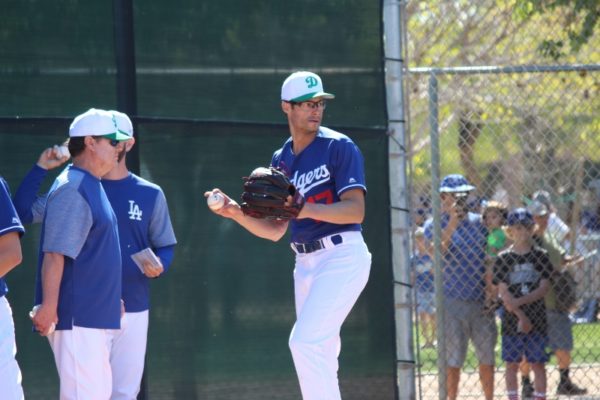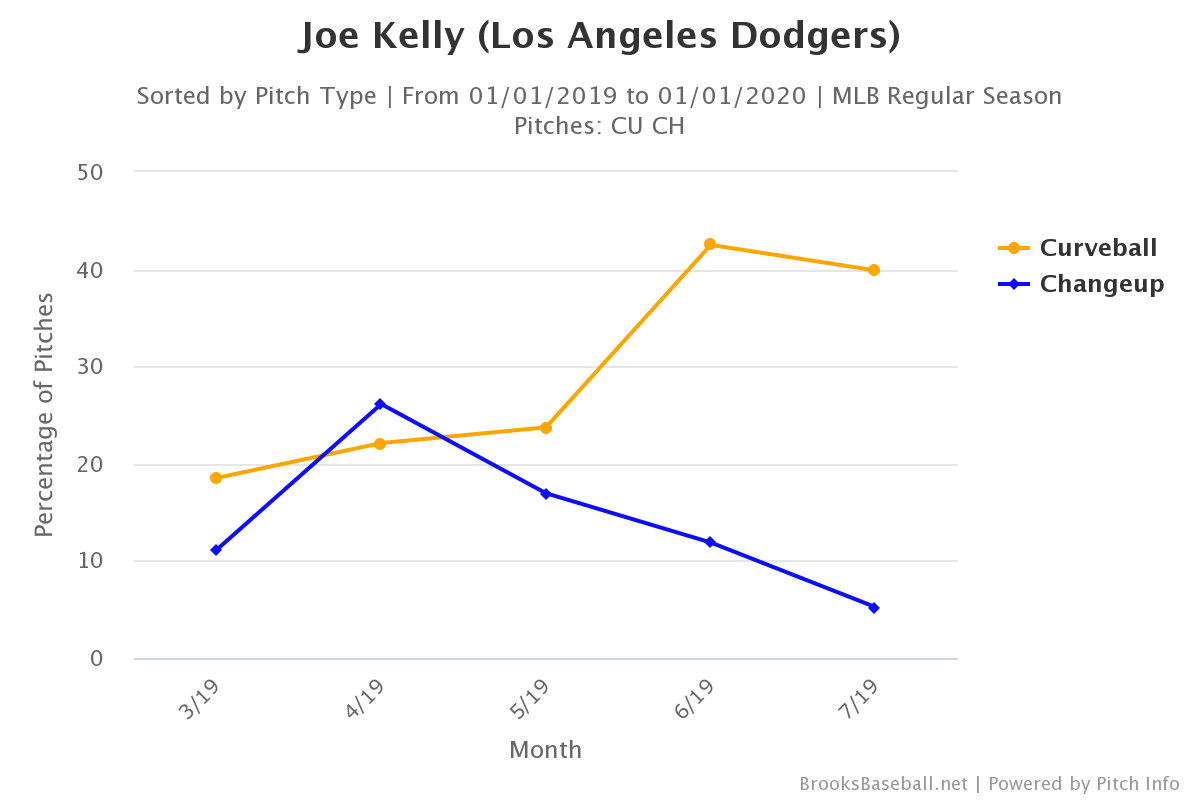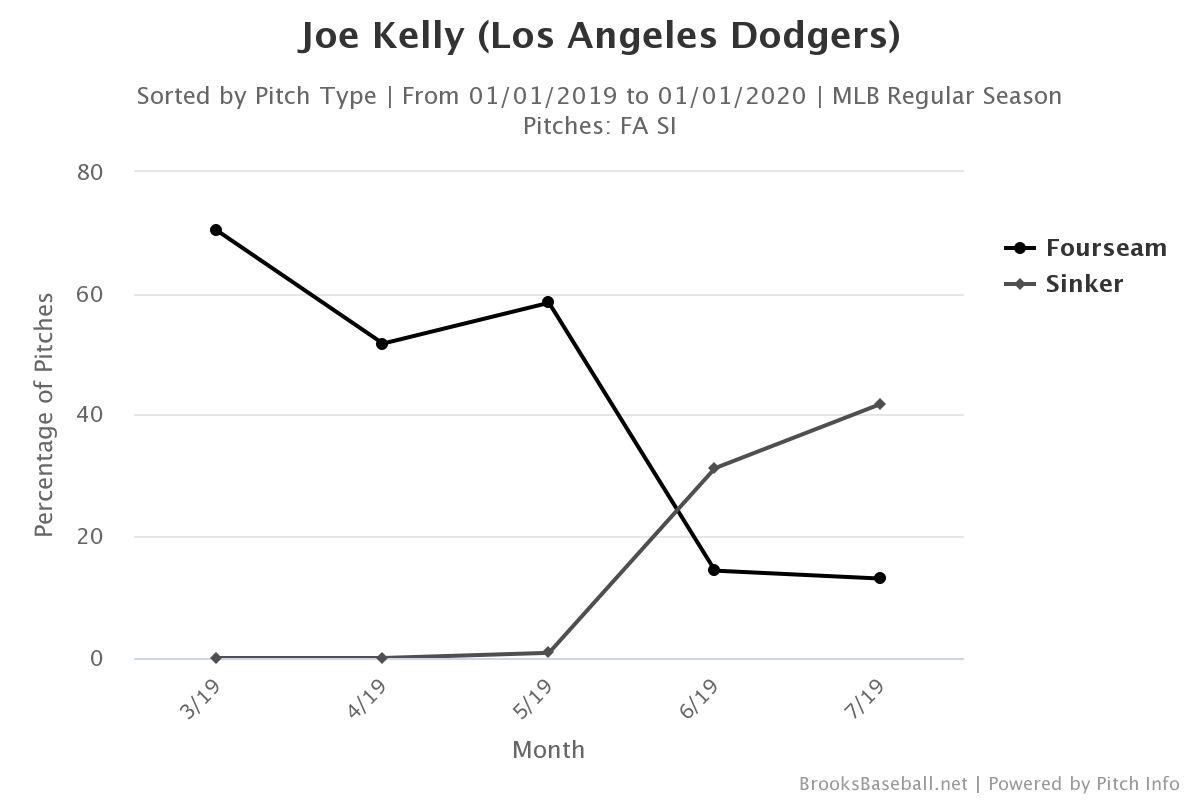The low point of Joe Kelly‘s season came on May 27th against the New York Mets. Pitching for the first time in nine days and far-removed from his desired high-leverage relief role, Kelly faced three batters. All three reached base. Two of them scored.
The disastrous appearance snapped a streak of four straight good outings for Kelly, another example of his maddening inconsistency. After the game, Twitter was full of calls to release Kelly; his 8.83 ERA in his first 17-1/3 innings pitched as a Dodger made his contract look like a lost cause already. When combining his early 2019 results with his 2018 playoff results, the sample upon which the Dodgers seemed to bet, the picture was bleak. At best, Kelly looked like a mediocre reliever, the same as he was before his playoff hot streak helped to dash the Dodgers’ title hopes. At worst, he looked unsalvagably broken.
Since that low point against the Mets and another mediocre outing the following day, Joe Kelly has been on a roll. Since the start of June, Kelly has allowed four earned runs in 18 innings pitched (good for a 2.00 ERA). Kelly has struck out 27 batters and walked eight over the last two months, and two-thirds of the balls in play against him have been hit on the ground. He has regained enough trust to be placed back into a higher leverage relief role, and his season peripherals are now not far away from closer Kenley Jansen‘s. After last night’s outing, he has been a good pitcher for the Dodgers for a longer stretch than the one in which he was a bad pitcher for the Dodgers.
——
Kelly is notoriously streaky, and this recent run is only a few innings longer than the short playoff stint which seemed like such a bad idea to bet upon. Obviously, everything within this new sample requires the same grain of salt that last October’s performance did. However, Kelly has made some significant changes since his disastrous first impression, some of which may help him down the stretch.
Through the end of May, the biggest difference between Kelly’s 2018 and 2019 pitch usage was a significant increase in the number of changeups thrown. In 2018, he threw the pitch just over 10% of the time, and in the first two months of this season that frequency more than doubled.
In the second half of last season, Kelly’s change was dominant. Between June 2nd and the end of the 2018 season, he threw the pitch 101 times. Batters managed just three singles, logged no extra-base hits, and missed nearly half of their swings. When the change was put in play, it was a ground ball more than 60% of the time. “Joe Kelly is under-using his change” was a reasonable conclusion to draw from the way he ended the year, and it seems like the front office thought Kelly would be more successful if he threw the pitch more often.
Kelly’s changeup wasn’t his biggest problem in his early-season slump, but the results on changes still lagged behind where they were at the end of 2018. The swing-and-miss rate dropped, and batters were hitting it hard when they put it in play. The results on his curve were even worse. However, despite this, Kelly began to adjust his off-speed mix in June:
Kelly’s curves have replaced his changes. So far, this adjustment has been wildly successful.
One extremely important key to Kelly’s success is keeping the ball on the ground. So far in the 2019 season, batters have a SLG of 1.050 against him when hitting the ball in the air. The expected slugging on those balls is about the same. That is lower than the 10th percentile in the league. When the ball is hit in the air against Kelly, it has typically been hit extremely hard.
However, since Kelly more-or-less ditched the change, he has only allowed four non ground-balls on the curve, out of 129 thrown. That amounts to a 77% rate (13 of 17) on curves put in play. Over the full 2019 season, Joe Kelly now owns the best ground ball rate on curves in the league (minimum 100 thrown), to go along with a top 20 swing-and-miss rate.
Kelly’s command of the curve has been less than perfect, but it has definitely improved. Only 61% of his curves are down in the zone or below during this hot streak, but that number was 20% lower over the first two months. He’s locating better, and his curveball that touches 91 mph is finally showing results that match its potential.
Replacing his changeup with curves is not the only thing Kelly has done during this hot streak. He has also mostly replaced his four-seam fastball with two-seamers:
This is an interesting break from an MLB-wide trend. Two-seam usage has been on the steady decline for years, partially because it makes it more difficult to work up in the zone. Four-seam fastballs are more favored for the current “tunneling” approach. However, you need good command to be a good tunneler, and command will never be Kelly’s strong suit, even during a stretch like this.
Kelly’s two-seamer rises 2.5 inches less than his four-seamer, but it runs three inches more, partially due to his unique arm action. Against right-handers in particular, he (sometimes accidentally) uses the pitch almost like a right-handed pitcher uses a cutter against lefties, getting the pitch on the hands for weak contact rather than to the back foot for a missed swing.
The results of incorporating the two-seam fastball have been mixed so far. Batters have a .360 average and a .440 slugging percentage on the pitch, compared to .269 and .442 on the four-seam. Crucially, though, the two-seams put in play are being kept on the ground at a 63% rate, compared to 50% on the four-seam. As a bonus, the two-seamer is missing bats more often than the four-seam was as well.
These changes have pushed Joe Kelly to the eighth-highest ground ball rate among relievers this year. Batters simply haven’t been able to lift the ball against him, and with the ball as lively as it is right now, that’s a huge step in the right direction. Perhaps the pitch mix change is more about a simplification of approach than the pitches themselves, but whatever it is, it’s working.
——
Of course, this sample of Joe Kelly being good is incredibly small, just like the postseason sample was last year. What happens after the next bad outing? Will Kelly maintain his composure and confidence? Will the changes stick? Only time can tell, and the occasional glimpses of the old Joe Kelly still poke through more often than the Dodgers would like.
However, things have changed to the point where this hot streak can’t be completely hand-waved away as another good stretch by an incredibly streaky player. Real things have changed in Joe Kelly’s approach. It’s enough for the Dodgers to hope that the playoff Kelly is finally back after all, just in a completely different form. After their inactive trade deadline, they really need this new success to stick.
 Dodgers Digest Los Angeles Dodgers Baseball Blog
Dodgers Digest Los Angeles Dodgers Baseball Blog


